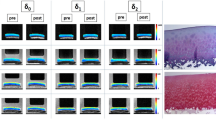Abstract
In this study we determined the efficiency of magnetization transfer magnetic resonance imaging (MT-MRI) to differentiate native and enzymatically degraded cartilage, using bovine sesamoid bones from the metacarpophalangeal joint as a model system. Gradual proteoglycan (PG) depletion was achieved by increasing incubation periods with testicular, hyaluronidase. For native cartilage a Ms/Mo ratio of 0.303±0.09 (mean±SEM) was measured. Biochemically determined PG diminution up to 50% correlated strongly (r=0.953) with changes in the Ms/Mo ratio. Further PG loss is not reflected in an equally drastic Ms/Mo increase, whereas subsequent treatment of PG-depleted cartilage samples with collagenase led to an additional rise in the Ms/Mo ratio. Proteoglycan depletion and the beginning destruction of the collagen structure were also assessed histochemically. Our study confirms that collagen contributes to the baseline MT effect observed in articular cartilage. However, the changes in the MT ratio in gradually PG-depleted cartilage with a largely intact collagen network indicate that PG contributes to the MT effect as well. Therefore MT-MRI might become a sensitive technique for the monitoring of subtle degradation changes in articular cartilage, the still inaccessible process in osteoarthritis.
Similar content being viewed by others
References
Kuettner K (1992)Articular Cartilage and Osteoarthritis (Kuettner K, ed.). New York: Raven Press, pp. 487–499.
Xia Y, Farquar T, Burton-Wurster N (1995) Self-diffusion monitors degraded cartilage.Arch Biochem Biophys 2: 323–328.
Lesperance LM, Gray ML, Burstein D (1992) Determination of fixed charged density in cartilage using nuclear magnetic resonance.J Orthopaedic Res 10: 1–13.
Kusaka Y, Gründer W, Rumpel H (1992) MR microimaging of articular cartilage and contrast enhancement by manganese ions.Magnetic Resonance Med 24: 137–148.
Wachsmuth L, Raiss RX, Juretschke HP (1996) Magic angle dependency and Mn2+-diffusion studies to define the biochemical status of articular cartilage.Proceedings of the 4th Meeting of the International Society of Magnetic Resonance Medicine, p. 837.
Peterfy CG, Majumdar S, Lang P (1994) MR imaging of the arthritic knee: improved discrimination of cartilage, synovium, and effusion with pulsed saturation transfer and fat-suppressed T1-weighted sequences.Radiology 191: 413–419.
Kim DK, Ceckler TL, Hascall VC (1993) Analysis of water-macromolecule proton magnetization transfer in articular cartilage.MRM 29: 211–215.
Gray ML, Burstein D, Lesperance LM (1995) Magnetization transfer in cartilage and its constituent macromolecules.MRM 34: 319–325.
Ceckler TL, Wolff SD, Yip V (1992) Dynamic and chemical factors affecting water proton relaxation by macromolecules.JMR 98: 637–645.
Farndale RW, Buttle DJ, Barret, AJ (1986) Improved quantitation and discrimination of sulphated glycosaminoglycans by the sue of dimethylmethylene blue.Biochim Biophys Acta 883: 173–177.
Rosenberg L (1971) Chemical basis for the histological use of safranin O in the study of articular cartilage.J Bone Joint Surg 53A: 69–82.
Romeis B (1989)Mikroskopische Technik (Böck P, ed.), Munich: Urban & Schwarzberg.
Author information
Authors and Affiliations
Rights and permissions
About this article
Cite this article
Wachsmuth, L., Juretschke, H.P. & Raiss, R.X. Can magnetization transfer magnetic resonance imaging follow proteoglycan depletion in articular cartilage?. MAGMA 5, 71–78 (1997). https://doi.org/10.1007/BF02592269
Received:
Accepted:
Issue Date:
DOI: https://doi.org/10.1007/BF02592269




